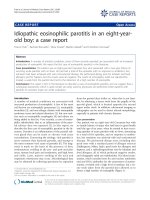Báo cáo khoa học: "Recurrent retroperitoneal Schwannomas displaying different differentiation from primary tumor: Case report and literature review" potx
Bạn đang xem bản rút gọn của tài liệu. Xem và tải ngay bản đầy đủ của tài liệu tại đây (2 MB, 5 trang )
CAS E REP O R T Open Access
Recurrent retroperitoneal Schwannomas
displaying different differentiation from primary
tumor: Case report and literature review
Zhong-qi Li
1
, Hai-yong Wang
1
, Jun Li
2
, Lisong Teng
1*
Abstract
Background: Retroperitoneal Schwannomas are uncommonly found in the retroperitoneum and few of them
show malignant transformation and invasion. Local recurrence are common in malignant Schwannomas with very
few reports of tumor distinct differentiation at recurrences.
Case presentation: We report here a rare case of retroperitoneal schwannoma with multiple origins from
retroperitoneum and pelvic wall. Pathological examination confirmed the case as a schwannoma with malig nant
transformation. Radical dissection of the tumors along with the sacrifice of adjacent sigmoid colon and left kidney
failed to provide a cure for this patient. Due to tumor recurrence, a second and a third surgery of radical excision
were performed 6 months and 17 months later after the first surgery, respectively. Histopathologic analysis
identified that the recurrent tumors were different from the original schwannoma because of their smoo th muscle-
like differentiation.
Conclusion: Malignant schwannomas are uncommon sarcomas with a high incidence of local recurrence. Distinct
immunohistochemical staining results of the tumors at recu rrence indicate their potential of smooth-muscle like
differentiation. Radical excision of the tumors may provide benefit for their local recurrences.
Background
Schwannomas are a rare variant of peripheral nerve
sheath tumors that seldomly develop to malignancy. In
the absence of Recklinghausen’s disease, these masses
rarely occur in the retroperitoneum, which has a
reported incidence of only 0.5-5% of all schwannomas
[1,2]. Schwannomas usually occur as solitary encapsu-
lated tumors with demarcated margins with ne ighbour
organs. We report our experience with a rare case of
malignant transformed schwannoma invading kidn ey
and sigmoid colon at its first occurrence. Tumors
recurred after complete resection along with adjacent
tissue and viscera. Interestingly, tumors showed smooth-
muscle like differentiation at recurrences.
Case Presentation
A large mass in the left lower quadran t of the abdomen
was found in a 51 ye ar old male patien t during physical
examination and confirmed by computer tomography.
The patient has no history of any c ancer and no family
history of neurofibromatosis. Lab tests results including
blood routine , urine routine, serum chemistry, as well as
examinations of several serum tumor markers such as
Carcinoembryonic antigen (CEA), a-fetoprotin (AFP)
and Carbohydrate antigen 19.9 (CA19.9) were all wi thin
normal ranges. Computed tomography scan confirmed a
15.0 × 12.3 × 10.0-cm enhancing heterogeneous mass
with left kidney invasion arising from retroperitoneal
space (Fig. 1). As shown in the CT scan, we could iden-
tify several smaller nodular lesions around the main
tumor, locating in the soft tissues of the pelvic wall and
sigmoid colon (Fig. 2 and Fig. 3). A presumptive diagno-
sis of retroperitoneal sarcoma o r possible pancreatic
neoplasm was suspected. The patient underwent surgical
excision of t he masses. The largest retroper itoneal mass
was speculated to be the original site upon examinations
* Correspondence:
1
Cancer Center, The First Affiliated Hospital, Zhejiang University School of
Medicine, Hangzhou, China
Full list of author information is available at the end of the article
Li et al. World Journal of Surgical Oncology 2010, 8:66
/>WORLD JOURNAL OF
SURGICAL ONCOLOGY
© 2010 Li et al; licensee BioMed Central Ltd. This is an Open Access articl e distributed under the terms of the Creative Commons
Attribution Licens e ( which permits unrestricted use, distribution, and reproduction in
any medium, provided the original work is properly cited.
during the operation. The nodules found on the sigmoid
colon were most likely “satellite” lesions , for it was con-
fined in the colon wall but did not protrude into the
colon cavity, which may due to direct spread of tumor
cells from the primary tumor. However, the pelvic
masses rooted from the pelvic wall but not from pelvic
peritoneum indicated they may have independent ori-
gins. The left kidney and sigmoid flexure were extir-
pated together with the tumors for the negative soft
tissue margins. No further anti-tumor therapy was
administrated after the surgery, and CT scan of the
abdomen and pelvic cavity was performed every three
months as follow-up. In the fol low-up examination
6 months post sur gery, a mass 7-cm in diameter
was discovered at the retroperitoneal site (Additional
file 1: Fig. S1). The mass was revealed to be well-
circumscribed and complete excision was performed.
The patient was doing well after the second surgery till
11 months after, the second surgery, when a recurrent
mass involving the splenic h ilum and cauda pancreatic
was r evealed by CT. A third surgery was performed to
resect the tumor together with the spleen and distal
pancreas. All of the three surgeries were performed to
obtain macroscopic clearance at resection.
Pathological findings
At first occurrence, the biggest primary mass had a grey
fish-meat like appearance on section with major solid
features. Histopathological analysis identified the tumor
as a schwannoma with m alignant transfor mation. It was
not grossly clear whether the lesion was associated with
a nerve trunk. Histologically, the lesion consisted of
spindle cells arranged in short bundles with occasional
palisading nuclei. Cytologic atypia is evident as charac-
terized by nuclear hyperchromasia, atypical mitotic
figures and tumor giant cells (F ig. 4 and Fig. 5 ). Sero-
muscular layer of sigmoid colon and renal ca psule were
invaded by tumor cells as shown in HE st ain ing section
(Additional file 2: Fig. S2 and Additional file 3: Fig. S3).
All the smaller nodular lesions on the colon and pelvic
cavity had the same histopathological characters with
the largest one and the immunohistochemical profile
were very similar.
Immunohistochemical studies were performed using a
panel of antibodies, including S-100, De smin, CK, EMA,
CD117 and SMA (Dako, CA, USA). All specimens from
the three surgical resection were negative for CK, EMA,
CD117 and SMA staining. Interestingly, the spindle cells
in the first resected specimen were positive for S-100
(Fig. 6A) but negative for Desmin (Fig. 6B). In contrast,
specimens from the later two operation were negative for
S-100 (Fig. 6C) but strongly positive for desmin (Fig. 6D).
Figure 1 Computed tomography (CT) showing a giant mass
located in the retroperitoneal space with invasion to the left
kidney.
Figure 2 CT scan showing tumors involved the sigmoid flexure.
Figure 3 CT scan showing smaller masses located in the pelvis
cavity.
Li et al. World Journal of Surgical Oncology 2010, 8:66
/>Page 2 of 5
These findings suggested diverse differentiation o f the
schwannoma at recurrences.
Discussion
Most previously reported cases of retroperitoneal
schwannomas were solitary tumors except for a few
reports of multiple tumors cases [3]. Our case showing
multiple tumo rs at different location simultaneously in
the absence of neuromatosis background was quite ra re.
In Voros’ s study, 7/29 cases presented with small nodu-
lar lesions around the main retroperitoneal tumor,
which turn out to be satellite tumors, having an adverse
effect on recurrence and survival rates [4]. The nodules
found on the sigmoid colon in our case most likely
represent “satellite” lesion, which may due to direct
spread of tumor cells from the primary tumor. However,
thepelviconeswereshowntobeoriginatedfromtis-
sues below the pe lvic peritoneum, which indicated these
tumors are of independent origins rather than metastasis
of the retroperitoneal tumor.
Very few Schwannomas were reported to undergo
malignant transformation and invade adjacent viscera,
including colon and kidney [5]. Although diffuse positiv-
ity for S100 protein in the cytoplasm of tumor cells is
the classical immunohistochemical staining feature of
benign schwannomas, the variants with malignant
degeneration lesion may vary. The diagnos is of malig-
nant peripheral nerve sheath tumor lacks standardized
diagnostic criteria except that features such as dense fas-
cicules in a “ marble-like” pattern consisting of asymme-
trically tapered spindle cells [1]. Malignancy is usually
characterized histologically by mitosis figures, pleo-
morphism, and blood vessel infiltration [6].
Schwannomas have been reported to be coexisted with
focal smooth muscle differentiation [7]. Controversy still
exists in the pathological diagnosis of the recurrent ret-
roperitoneal tumors. The cellular areas in the second
surgical specimen showed strong desmin expression but
not S-100. In view of this expression pattern, a diagnosis
of schwannoma was felt to be less likely and a report of
low-grade sarcoma, possibly showing smooth muscle
differentiation was issued. However, distinct immunohis-
tochemical staining results in our case might also indi-
cate different directions of differentiation of the
malignant schwannoma. One possible explanation for
this observation may be the schwannoma was derived
from multipotential neural cells that could have devel-
oped into various phenotypes. This theory can also
explain the different types of elements found in the
schwannoma [8,9].
Malignant schwannomas are aggressive tumors that
act as high-grade sarcomas with a high incidence of
local recurrence or distant me tastasis [10]. Recurrence,
however, has been reported to occur usual ly within
6 months of the initial surgical treatment [11]. The rates
of local recurrence range from 16% to 54% after conser-
vative intralesional enucleation [12]. According to a
recent view of the surgical management of primary ret-
roperitoneal sarcomas, the completeness of resection
and tumor grade are the most important predictors of
local recurrence and overall survival [13]. The prognosis
of this schwannomas with malignant transformation is
correlated with tumor location, degree of differentiation,
adjacent invasion and thoroughness of surgical excision
[1,14], h owever, to the best of our knowledge, the risk
of recurrence for this type of rare tumors has not yet
been systematically studied. In our case, the reason of
repeated recurrences within a relatively short period is
unknown, we wonder whether multiple origins and
Figure 5 Benign part of the tumor showing hypocellular area
without features of cytologic atypia. (Original magnification 200×).
Figure 4 Images of HE staining showing the schwannoma
undergoing malignant transformation. High-power view of the
spindle cell component showing bland cytologic features with a
suggestion of palisading, mitotic figures and tumor giant cells.
(Original magnification 200×).
Li et al. World Journal of Surgical Oncology 2010, 8:66
/>Page 3 of 5
evident malignancy features such as atypical mitosis,
giant tumor cell, local organ invasion may be two of the
risk factors.
Radical excision is considered t o be the best way to
treat retroperitoneal neural sheath tumors, however,
considerable controversy exists concerning the soft tis-
sue margins that are negative of tumor invasion [1].
Some authors ar gued for complete surgical excision that
may include, if necessary, the sacrifice of adjacent tissue
and viscera [15,16]. Others believe that since schwan-
noma is usually a benign mass, a simple enucleation or
partial excision of the tumor is sufficient [17,18]. Re-
operation may provide a cureforthelocallyrecurred
schwannoma [19]. Nevertheless, in our case, although a
complete excision of the tumor with the clear adjacent
tissue margins was executed in t he first operation,
recurrence occurred within 6 months and a second radi-
cal excision operation could not prevent its recurrence
at the same location for a third time. Since adjuvant
radiotherapy and chemotherapy did not appear to pro-
vide any proven benefit and the single most important
prognosis factor is aggressively successful en bloc resec-
tion of the primary tumor, no adjuvant therapy after
surgery was given in our case [20]. The patient is cur-
rently doing well 6 months after the third surgery, how-
ever, long-term follow-ups are warranted for this rare
case of multiple and recurrent schwannoma.
Conclusion
Malignant schwannomas are uncommon sarcomas with a
high incidence of local recurrence. Distinct immunohisto-
chemical staining results of the tumors at recurrence
Figure 6 Immunohistochemical featur es of S -100 and desmin staining in the primary retroperitoneal mass (A and B) and recurrent
masses (C and D). The spindle cells of the largest primary mass were positive for S-100 protein (1+) (A) and negative for desmin (B). The
spindle cell component of the recurrent mass was negative for S-100 staining (C), while showed strong immunoreactivity to desmin (D). (Original
magnification200×).
Li et al. World Journal of Surgical Oncology 2010, 8:66
/>Page 4 of 5
indicate their potential of smooth-muscle like differentia-
tion. Radical excision of the tumors may provide benefit
for their local recurrences.
Additional material
Additional file 1: Fig S1. Recurrent schwannoma. Schwannoma
recurred at the retroperitoneal space 6 months later after the first surgery
as indicated by arrow.
Additional file 2: Fig S2. Tumor invading colon. Pathological findings
showed the tumor invasion to the colon seromuscular layer. (Original
magnification 200×).
Additional file 3: Fig S3. Tumor invading kidney. Pathological findings
showed the tumor invasion to renal capsule. (Original magnification
200×).
Consent
Written informed consents were obtained from the patient for publication
of this case report and accompanying images. Copies of the written consent
are available for review upon request.
Competing interests
The authors declare that they have no competing interests.
Authors’ contributions
WHY wrote the initial draft. LZQ and WHY contributed equally to this work.
TLS is the guarantor. All authors read and approved the final manuscript.
Funding support
This study was partly supported by National Basic Research Program of
China (973 Program, No.2009CB521704).
Acknowledgements
We thank Qihan You for technical assistance.
Author details
1
Cancer Center, The First Affiliated Hospital, Zhejiang University School of
Medicine, Hangzhou, China.
2
Department of Pathology, The First Affiliated
Hospital, Zhejiang University School of Medicine, Hangzhou, China.
Received: 25 April 2010 Accepted: 9 August 2010
Published: 9 August 2010
References
1. Cury J, Coelho RF, Srougi M: Retroperitoneal schwannoma: case series
and literature review. Clinics 2007, 62:359-62.
2. Li Q, Gao C, Juzi JT, Hao X: Analysis of 82 cases of retroperitoneal
schwannoma. ANZ J Surg 2007, 77:237-40.
3. Hurley S, Smith JJ, Larsen CR, Silverman ML: Multiple retroperitoneal
schwannomas: case report and review of the literature. J Urol 1994,
151:413-6.
4. Voros D, Theodorou D, Ventouri K, Prachalias A, Danias N, Gouliamos A:
Retroperitoneal tumors: do the satellite tumors mean something? JSurg
Oncol 1998, 68:30-3.
5. Enzinger FM, Weiss SW: Benign tumors of peripheral nerves. Soft Tissue
Tumours St Louis: MosbyEnzinger FM, Weiss SW , 3 1995, 821-888.
6. Chen KT, Latorrace R, Fubich D, Padgug A, Hafez G, Gilbert EF: Malignant
schwannoma: A light microscopy and ultrastructural study. Cancer 1980,
45:1583-1593.
7. Anderson CE, Salter DM: Schwannoma with focal smooth muscle
differentiation: a potential pitfall in the interpretation of core biopsies.
Histopathology 2005, 46:592-594.
8. Ducatman BS, Scheithauer BW: Malignat peripheral nerve sheath tumors
with divergent differentiation. Cancer 1984, 54:1049-1057.
9. Chuang ST, Wang HL: An unusual case of glandular schwannoma. Hum
Pathol 2007, 38:673-677.
10. Takatera H, Takiuchi H, Namiki M, Takaha M, Ohnishi S, Sonoda T:
Retroperitoneal schwannoma. Urology 1986, 28:529-531.
11. White HR: Survival in malignant schwannoma. Cancer 1971, 27:720-729.
12. Andonian S, Karakiewicz PI, Herr HW: Presacral cystic schwannoma in a
man. Urology 2003, 62:8-10.
13. Strauss DC, Hayes AJ, Thway K, Moskovic EC, Fisher C, Thomas JM: Surgical
management of primary retroperitoneal sarcoma. Br J Surg 2010,
97:698-706.
14. Song JY, Kim SY, Park EG, Kim CJ, Kim DG, et al: Schwannoma in the
retroperitoneum. J Obstet Gynaecol Res 2007, 33:371-375.
15. Daneshmand S, Youssefzadeh D, Chamie K, Boswell W, Wu N, Stein JP,
Boyd S, Skinner DG: Benign retroperitoneal schwannoma: A case series
and review of literature. Urology
2003, 62:993-997.
16. Girgin C, Ozkan U, Sezer A, Tugyan N: A large pelvic schwannoma causing
bilateral hydronephrosis. Int J Urol 2003, 10:616-618.
17. Gubbay AD, Moschilla G, Gray BN, Thompson I: Retroperitoneal
schwannoma: a case series and review. Aust N Z J Surg 1995, 65:197-200.
18. Regan JF, Juler GL, Schmutzer KJ: Retroperitoneal neurilemoma. Am J Surg
1977, 134:140-145.
19. Abernathey CD, Onoerio BM, Scheithauer B, Pairolero PC, Shives TC:
Surgical management of giant sacral schwannomas. J Neurosurg 1986,
65:286-295.
20. Pirayesh A, Chee Y, Helliwell TR, Hershman MJ, Leinster SJ, Fordham MV,
Poston GJ: The management of retroperitoneal soft tissue sarcoma: a
single institution experience with a review of the literature. Eur J Surg
Oncol 2001, 27:491-497.
doi:10.1186/1477-7819-8-66
Cite this article as: Li et al.: Recurrent retroperitoneal Schwannomas
displaying different differentiation from primary tumor: Case report and
literature review. World Journal of Surgical Oncology 2010 8:66.
Submit your next manuscript to BioMed Central
and take full advantage of:
• Convenient online submission
• Thorough peer review
• No space constraints or color figure charges
• Immediate publication on acceptance
• Inclusion in PubMed, CAS, Scopus and Google Scholar
• Research which is freely available for redistribution
Submit your manuscript at
www.biomedcentral.com/submit
Li et al. World Journal of Surgical Oncology 2010, 8:66
/>Page 5 of 5









